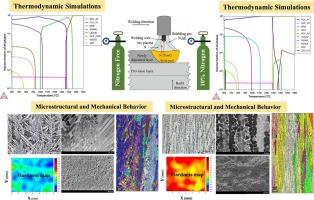电弧增材制造中原位气相合金化控制凝固模式和设计混杂不锈钢的新方法
IF 7.9
2区 材料科学
Q1 MATERIALS SCIENCE, MULTIDISCIPLINARY
引用次数: 0
摘要
本研究提出了一种在电弧增材制造(WAAM)中采用热动力学引导的原位气相合金化方法,通过将初始凝固模式从δ-铁素体转变为γ-奥氏体来增强双相不锈钢,从而生产出具有连续奥氏体基体的富氮合金,该合金具有双相级强度和优越的延展性。热力学计算指导保护气体中氮的调节,以控制凝固和发展高性能的微观组织。热力学-动力学模型预测了电弧等离子体对氮的吸收,使气体成分的选择促进了从δ-铁素体到γ-奥氏体作为主要凝固相的转变。氮含量分析和Scheil模拟证实了在约0.7 wt%的氮下向奥氏体优先凝固的转变。电子背散射衍射和光学显微镜分析结果表明,富氮(HN)样品具有连续的γ-奥氏体基体和分散的δ-铁素体,而贫氮(LN)样品具有δ-铁素体基体和孤立的γ-奥氏体岛。HN样品显示出更大的晶粒取向扩展,表明内部取向错误增加。尽管有明显的晶体结构,但HN样品表现出几乎各向同性的拉伸行为,并具有增强的屈服强度、抗拉强度、高达11%的硬度和提高的延伸率。这些发现表明,通过气相合金化控制熔体化学可以在不改变填充丝的情况下实现具有优异机械性能的相工程显微组织。本文章由计算机程序翻译,如有差异,请以英文原文为准。

A novel in-situ gas-phase alloying approach in wire arc additive manufacturing for controlling solidification mode and designing hybrid stainless steels
This study presents a thermodynamically guided in-situ gas-phase alloying approach in wire arc additive manufacturing (WAAM) to enhance duplex stainless steels by shifting the primary solidification mode from δ-ferrite to γ-austenite, producing a nitrogen-enriched alloy with a continuous austenitic matrix that combines duplex-grade strength with superior ductility. Thermodynamic calculations guided nitrogen adjustment in the shielding gas to control solidification and develop high-performance microstructures. Thermodynamic–kinetic modeling predicted nitrogen uptake from the arc plasma, enabling gas composition selection to promote a shift from δ-ferrite to γ-austenite as the primary solidification phase. Nitrogen content analysis and Scheil simulations confirmed a transition to austenite-first solidification at approximately 0.7 wt% nitrogen. Electron Backscatter Diffraction and optical microscopy revealed that nitrogen-enriched (HN) samples exhibited a continuous γ-austenitic matrix with finely dispersed δ-ferrite, whereas nitrogen-lean (LN) samples had a δ-ferritic matrix with isolated γ-austenite islands. HN samples showed greater grain orientation spread, indicating increased internal misorientation. Despite pronounced crystallographic texture, the HN samples demonstrated nearly isotropic tensile behavior along with enhanced yield strength, tensile strength, ∼11 % higher hardness, and improved elongation. These findings demonstrate that melt chemistry control via gas-phase alloying enables phase-engineered microstructures with superior mechanical performance without modifying the filler wire.
求助全文
通过发布文献求助,成功后即可免费获取论文全文。
去求助
来源期刊

Materials & Design
Engineering-Mechanical Engineering
CiteScore
14.30
自引率
7.10%
发文量
1028
审稿时长
85 days
期刊介绍:
Materials and Design is a multi-disciplinary journal that publishes original research reports, review articles, and express communications. The journal focuses on studying the structure and properties of inorganic and organic materials, advancements in synthesis, processing, characterization, and testing, the design of materials and engineering systems, and their applications in technology. It aims to bring together various aspects of materials science, engineering, physics, and chemistry.
The journal explores themes ranging from materials to design and aims to reveal the connections between natural and artificial materials, as well as experiment and modeling. Manuscripts submitted to Materials and Design should contain elements of discovery and surprise, as they often contribute new insights into the architecture and function of matter.
 求助内容:
求助内容: 应助结果提醒方式:
应助结果提醒方式:


